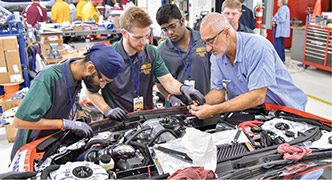
Argonne National Laboratory highly encourages scientific research–both within the universities and in collaboration with government and industry.
Latest News
June 1, 2017
To foster the innovation used for automotive design and technology, the Argonne National Laboratory in Illinois hosts a design competition, principally with North American universities, to connect great minds.
Kristen Wahl is the director of the Advanced Vehicle Technology Competition (AVTC) program at Argonne National Laboratory. We spoke to Wahl to understand its EcoCAR 3 program. Here’s our conversation.
Digital Engineering: Can you provide an overview of the “EcoCAR 3” program, how it came to be and the intent of the program?
Kristen Wahl: EcoCAR 3 is the most recent advanced vehicle technology competition (AVTC) series sponsored by DOE (U.S. Department of Energy) and GM. Argonne National Laboratory has managed the AVTC program for DOE, in collaboration with the domestic automotive industry since the program began in 1988, seeding more than 20,000 graduates into the automotive and related industries.
 Argonne National Laboratory highly encourages scientific research–both within the universities and in collaboration with government and industry.
Argonne National Laboratory highly encourages scientific research–both within the universities and in collaboration with government and industry.EcoCAR 3 challenges 16 North American universities to reduce the environmental impact of vehicles by minimizing fuel consumption and reducing emissions, while improving the vehicle’s overall consumer appeal. Teams will follow a real-world vehicle development process (VDP) to design and integrate their advanced technology solutions into a 2016 Camaro donated by General Motors, gaining hands-on experience with industry-leading engineering tools and the latest vehicle components and technologies.
The number of students on each team varies. Typically teams have about 15 to 20 core students, but average 72 students working on the project at their university. Each team will send approximately 13 students and faculty members to the final competition in Milford, MI, and Washington, DC in May.
DE: Can you provide some examples of what the event has produced or what you expect it to produce?
Wahl: Teams each have unique innovation concepts, so the results of this research are as varied as the projects themselves. However, with the current direction of the automotive industry, many teams are working on approaches to improve vehicle fuel efficiency through connected or “smart” vehicle concepts, where the car can make intelligent decisions to improve efficiency based on real-time information.
For example, the University of Alabama has begun research into developing a two-mode homogeneous charge compression ignition (HCCI) strategy that is designed to be validated in their competition vehicle. HCCI marries the favorable characteristics of compression and spark ignition engines to achieve thermal efficiencies usually only seen in diesel vehicles. This dual mode is theorized to have the potential to meet modern emissions standards with little exhaust after-treatment.
Wayne State University has selected to investigate the feasibility of using the directed energy deposition (DED) process to fabricate structural and torque-transmitting components for use within their competition vehicle. The intended result will be successful application of a multi-material additive manufacturing process to provide spatial control over placement of multiple materials within the work part during the build sequence.
DE: Anything else you can tell us about the event?
Wahl: Our competitions have historically challenged teams to work with new and emerging vehicle technologies. In EcoCAR 3, we’re continuing that tradition through our Advanced Driver Assistance Systems activities, where teams are developing computer vision sensors to see and comprehend the roadway situation around them. Teams are using vision sensors to identify vehicles, pedestrians, signs and other elements of the road. More importantly, they will use that information to increase the driver’s situational awareness and improve vehicle efficiency.
Subscribe to our FREE magazine, FREE email newsletters or both!
Latest News
About the Author
Jim Romeo is a freelance writer based in Chesapeake, VA. Send e-mail about this article to [email protected].
Follow DE





